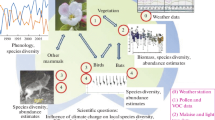Abstract
The design and application of automatic video recording systems for wild animals are described. Such systems enable continuous, long-time and repercussion-free surveillance of selected areas in the field. The performance characteristics of a conventional VHS video-tape system are compared to a digital video recording system. The recordings were used to develop daily and annual plots of occurrence for the different species and to display the preferences for darkness, twilight and light phase by the different species over the year. Absolute utilisation frequency as well as relative species composition can be obtained and compared between seasons or different places. The videos also were analysed for time budgets of basic behaviour patterns like feeding, walking, observing, social interaction, flight and comfort behaviour. Automatic video technique is a highly convenient tool for systematic long-term field research on occurrence of wild animal species, daily and annual activity rhythms, behaviour and area utilisation. Such systems can be applied especially to record animals at clearings, feeding or bait places, water sources, salt licks or traps.







Similar content being viewed by others
References
Alexy KJ, Gassett JW, Osborn DA, Miller KV (2001) Remote monitoring of scraping behaviors of a wild population of white-tailed deer. Wildl Soc Bull 29:873–878
Baker SE, Ellwood SA, Watkins R, MacDonald DW (2005) Non-lethal control of wildlife: using chemical repellents as feeding deterrents for the European badger Meles meles. J Appl Ecol 42:921–931
Bauer JW, Logan KA, Sweanor LL, Boyce WM (2005) Scavenging behavior in puma. Southwest Nat 50:466–471
Beringer J, VerCauteren KC, Millspaugh JJ (2003) Evaluation of an animal-activated scarecrow and a monofilament fence for reducing deer use of soybean fields. Wildl Soc Bull 31:492–498
Campbell TA, Langdon CA, Laseter BR, Ford WM, Edwards JW, Miller KV (2006) Movements of female white-tailed deer to bait sites in West Virginia, USA. Wildl Res 33:1–4
Chesson J (1978) Measuring preference in selective predation. Ecology 59:211–215
Church JS, Martz DG (2005) The use of digital video recorders (DVR) for capturing digital video files for use in both The Observer® and EthoVision®. In: Noldus LPIJ, Grieco F, Loijens LWS, Zimmermann PH (eds) Proceedings of measuring behavior. Noldus Information Technology, Wageningen, pp 241–244
Cutler TL, Swann DE (1999) Using remote photography in wildlife ecology: a review. Wildl Soc Bull 27:571–581
Hernandez L, Laundre JW, Gurung M (2005) From the field: use of camera traps to measure predation risk in a puma-mule deer system. Wildl Soc Bull 33:353–358
Jacobson HA, Kroll JC, Browning RW, Koerth BH, Conway MH (1997) Infrared-triggered cameras for censusing white-tailed deer. Wildl Soc Bull 25:547–556
Jaeger JR, Wehausen JD, Bleich VD (1991) Evaluation of time-lapse photography to estimate population parameters. Desert Bighorn Council Transactions 35:5–8
Kucera TE, Barrett RH (1993) The trailmaster (R) camera system for detecting wildlife. Wildl Soc Bull 21:505–508
Locke SL, Cline MD, Wetzel DL, Pittman MT, Brewer CE, Harveson LA (2005) From the field: a web-based digital camera for monitoring remote wildlife. Wildl Soc Bull 33:761–765
Main MB, Richardson LW (2002) Response of wildlife to prescribed fire in southwest Florida pine flatwoods. Wildl Soc Bull 30:213–221
Manly BFJ, McDonald LL, Thomas DL (1993) Resource selection by animals. Chapman and Hall, London
Pina GPL, Gamez RAC, Gonzalez CAL (2004) Distribution, habitat association, and activity patterns of medium and large sized mammals of Sohora, Mexico. Nat Areas J 24:354–357
Prins HHT, Bokdam J (1990) Habitat use of wild ungulates: discussion. In: Groot Bruinderink GWTA, Van Wieren SE (eds) Methods for the study of large mammals in forestry ecosystems. Proc. Workshop, Arnhem, The Netherlands, pp 15–17 (Dec. 1988, pp 36–43)
Reif V, Tornberg R (2006) Using time-lapse digital video recording for a nesting study of birds of prey. Eur J Wildl Res 52:251–258
Wood L, Huggins JA, Wofford HW (1999) Utilization of mineral licks by mammals with special emphasis on white-tailed deer. J Tenn Acad Sci 73:103
Acknowledgements
The results of the study were achieved during the research project “Resting areas for wildlife in Brandenburg,” supported by the Ministry for Rural Development, Environment and Consumer Protection Brandenburg (MLUV) by funding from hunting taxes. We acknowledge the kind support of the forest administration Groß Schönebeck, especially of the commissioner of wood and forest, Mr. K. Diezel.
Author information
Authors and Affiliations
Corresponding author
Additional information
Communicated by W. Lutz
Electronic supplementary material
Below is the link to the electronic supplementary material.
Supplementary Fig. 1
(JPEG 29 kb)
Supplementary Fig. 2
(JPEG 25 kb)
Supplementary Fig. 3
(JPEG 27 kb)
Supplementary Fig. 4
(JPEG 25 kb)
Supplementary Fig. 5
(JPEG 31 kb)
Supplementary Fig. 6
(JPEG 28 kb)
Rights and permissions
About this article
Cite this article
Scheibe, K.M., Eichhorn, K., Wiesmayr, M. et al. Long-term automatic video recording as a tool for analysing the time patterns of utilisation of predefined locations by wild animals. Eur J Wildl Res 54, 53–59 (2008). https://doi.org/10.1007/s10344-007-0108-0
Received:
Revised:
Accepted:
Published:
Issue Date:
DOI: https://doi.org/10.1007/s10344-007-0108-0




